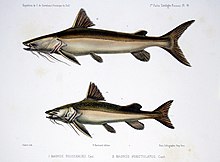| Brachyplatystoma rousseauxii | |
|---|---|

| |
| Conservation status | |
 Vulnerable (IUCN 3.1) | |
| Scientific classification | |
| Domain: | Eukaryota |
| Kingdom: | Animalia |
| Phylum: | Chordata |
| Class: | Actinopterygii |
| Order: | Siluriformes |
| Family: | Pimelodidae |
| Genus: | Brachyplatystoma |
| Species: | B. rousseauxii |
| Binomial name | |
| Brachyplatystoma rousseauxii (Castelnau, 1855) | |
| Synonyms | |
| |
Brachyplatystoma rousseauxii, the gilded catfish or dourada, is a species of catfish of the family Pimelodidae that is native to the Amazon and Orinoco River basins and major rivers of French Guiana.
Named in honor of Louis Rousseau (1811-1874), assistant naturalist, Muséum d’histoire naturelle in Paris.
Description
It grows to a length of 192 cm. Body is characterized by platinum head and gold body. Adults have short barbels. Caudal-fin in adults deeply-forked with narrow lobes.
Distribution
It is a much widespread species that is found in fluvial systems in the Guianas and northeastern Brazil and Amazon and Orinoco river drainage.
Ecology
It is a demersal fish commonly inhabits deeper, flowing channels. It is primarily piscivorous, with the adults taking a wide variety of fish: recorded prey include other catfish (Auchenipterus nuchalis, Cetopsis coecutiens, Hypoptopoma sp., Pinirampus pirinampu, Pimelodus sp., Platysilurus barbatus), characiformes (Curimata sp., Hydrolycus scomberoides, Mylossoma duriventris, Potamorhina spp., Prochilodus nigricans, Psectrogaster spp., Schizodon fasciatus, Tetragonopterus sp., Triportheus spp.) and anchovies. 42.8% of dourada surveyed had consumed plant matter, and 1.8% ate insects. Larvae drifting downriver consume invertebrates, such as planktonic crustaceans and aquatic insects.
Developing larvae are carried downriver by the flow, all the way to estuarine habitats. Juveniles and sub adults are migratory, traveling upriver back to its spawning grounds. It is considered to have the longest freshwater migration of any known fish species, with some fish travelling 5,500 kilometres (3,400 mi) from the mouth of the Amazon to its spawning grounds. Females mature at larger sizes than males, both at around 80 centimetres (31 in); in the Caqueta, they matured between their 3rd and 4th year, which is later than the fish in the Peruvian Amazon which mature around 2.5 years old. Longevity is estimated at 11-13 years old; a 143 centimetres (56 in) female was measured to be 12.9 years old.
Relation to humans
The dourada is an important species for fisheries, being considered one of two most important catfish species in that regard, and considered the most important in the western Amazon.
Notes
- ("golden" in Portuguese, a common name for fish)
References
- Reis, R. & Lima (March 2024). "Gilded Catfish IUCN". IUCN Red List of Threatened Species. Retrieved 2023-03-05.
- ^ Froese, Rainer; Pauly, Daniel (eds.). "Brachyplatystoma rousseauxii". FishBase. June 2020 version.
- ^ "Cat-eLog - Pimelodidae - Brachyplatystoma rousseauxii". Planet Catfish. Retrieved 2020-06-02.
- Córdoba, Edwin Agudelo; León, Ángela Viviana Joven; Bonilla-Castillo, César Augusto; Petrere Junior, Miguel; Peláez, Marlón; Duponchelle, Fabrice (2013). "Breeding, growth and exploitation of Brachyplatystoma rousseauxii Castelnau, 1855 in the Caqueta River, Colombia". Neotropical Ichthyology. 11 (3): 637–647. doi:10.1590/S1679-62252013000300017.
- "Order SILURIFORMES: Families HEPTAPTERIDAE, PHREATOBIIDAE, PIMELODIDAE and PSEUDOPIMELODIDAE". 13 September 2016.
- ^ "Brachyplatystoma rousseauxii (CASTELNAU, 1855) - Dourada". Seriously Fish. Retrieved 2020-06-02.
- Vasquez, Aurea Garcia; SÁNCHEZ-RIBEIRO, Homero; Rodriguez, Ronald Alexander; Montreuil-Frias, Victor Hugo. "HÁBITOS ALIMENTICIOS DEL DORADO Brachyplatystoma rousseauxii (Castelnau, 1855) EN LA AMAZONÍA PERUANA". researchgate.net. Folia Amazónica. Retrieved 10 November 2024.
- Márquez-Velásquez, Viviana; Leite, Rosseval Galdino; Hernandez-Serna, Andres; Alvarado, Fredy (2021). "Larval diet of two Amazonian goliath catfish species". Journal of Fish Biology. 98 (1): 333–336. Bibcode:2021JFBio..98..333M. doi:10.1111/jfb.14565. PMID 32997350. Retrieved 10 November 2024.
- Rojas, María; Olivera, Robinson; Quispe, Roberto; Hernán, Ortega (July 2007). "Estudio preliminar de ictioplancton de la Amazonia peruana con énfasis en la familia Pimelodidae (Preliminary study of the Peruvian Amazon ichthyoplankton with emphasis on the Pimelodidae family)". Revista Peruana de Biología. 13 (3). Peru Biol.: 263–266. doi:10.15381/rpb.v13i3.2354. Retrieved 10 November 2024.
- ^ Batista, J.S.; Alves-Gomes, J.A. (2006). "Phylogeography of Brachyplatystoma rousseauxii (Siluriformes - Pimelodidae) in the Amazon Basin offers preliminary evidence for the first case of "homing" for an Amazonian migratory catfish". Genetics and Molecular Research. 5 (4): 723–740. PMID 17183483. Archived from the original on 2007-09-28. Retrieved 2007-04-17.
- Jimenez, Erica Antunez; Filho, Mutsuo Asano; Frédou, Flávia Lucena (June 2013). "FISH BYCATCH OF THE LAULAO CATFISH Brachyplatystoma vaillantii (VALENCIENNES, 1840) TRAWL FISHERY IN THE AMAZON ESTUARY". Brazilian Journal of Oceanography. 61 (2): 129–140. doi:10.1590/S1679-87592013000200005. Retrieved 10 November 2024.
- Jimenez, Erica Antunes; Filho, Mutsuo Asano; Frédou, Flávia Lucena. "FISH BYCATCH OF THE LAULAO CATFISH Brachyplatystoma vaillantii (VALENCIENNES, 1840) TRAWL FISHERY IN THE AMAZON ESTUARY". scielo.br. BRAZILIAN JOURNAL OF OCEANOGRAPHY. Retrieved 10 November 2024.
- Barthem, Ronaldo B.; Goulding, Michael; Leite, Rosseval G.; Cañas, Carlos; Forsberg, Bruce; Venticinque, Eduardo; Petry, Paulo; Ribeiro, Mauro L. de B.; Chuctaya, Junior; Mercado, Armando (2016). "Goliath catfish spawning in the far western Amazon confirmed by the distribution of mature adults, drifting larvae and migrating juveniles". Scientific Reports. 7: 41784. doi:10.1038/srep41784. PMC 5292968. PMID 28165499.
- ^ Córdoba, Edwin Agudelo; León, Ángela Viviana Joven; Bonilla Castillo, César Augusto; Petrere Junior, Miguel; Peláez, Marlón; Duponchelle, Fabrice. "Breeding, growth and exploitation of Brachyplatystoma rousseauxii Castelnau, 1855 in the Caqueta River, Colombia". scielo.br. Neotropical Ichthyology. Retrieved 10 November 2024.
External links
| Taxon identifiers | |
|---|---|
| Brachyplatystoma rousseauxii | |
This Pimelodidae-related article is a stub. You can help Misplaced Pages by expanding it. |